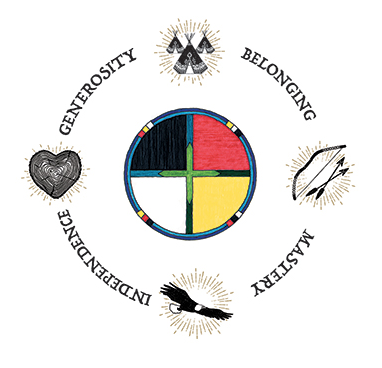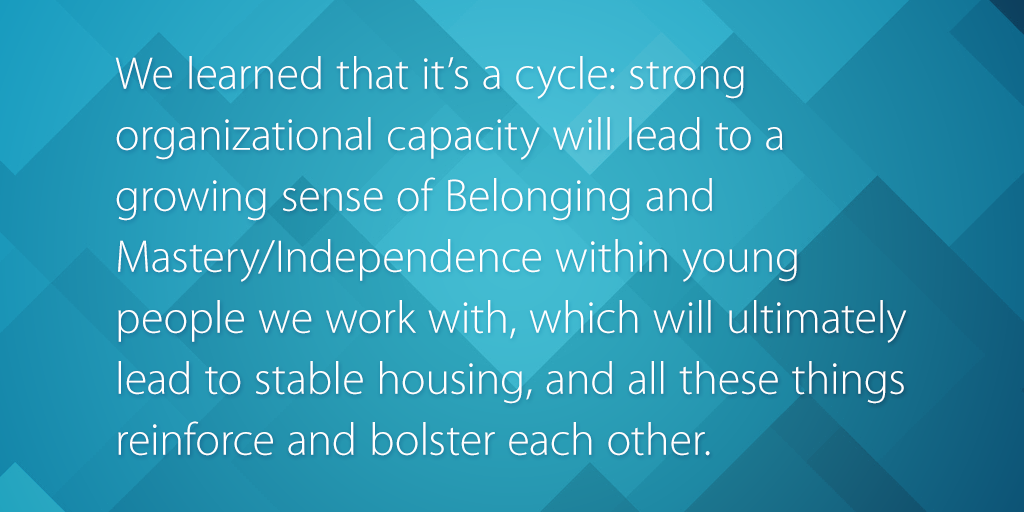How do we know the services and supports we provide to youth experiencing homelessness make their lives better in the long run? Any organization serving youth is prone to assume their interventions are making a difference. But how do we critically measure that impact? Do we open space for young people and their allies to identify the benchmarks on what an improved quality of life means to youth? How can we address evaluation differently, doing “nothing for youth without youth,” decolonizing our approaches, and building accountability into our communities?
A New Outcomes Framework
These questions have become so important at Eva’s Initiatives for Homeless Youth, and we’ve noticed that other youth-serving partners in Toronto have been asking them as well. So Eva’s connected with the research and evaluation team at the Canadian Observatory on Homelessness to take a crack at developing a new outcome measurement framework for our work with youth experiencing homelessness. We started the process by reviewing of the literature on:
a) factors related to youth exiting homelessness; and
b) existing outcome frameworks.
We applied the learnings from the literature reviews to guide our exploration at Eva’s through: a focus group with youth residents at Eva’s transitional housing facility; a focus group and visioning session with Eva’s staff team members; and a consultation with Executive Directors of sister youth-serving agencies.
The voices of young people and their allies gave us valuable insights. For instance, when we asked youth what outcomes mattered to them, they certainly addressed financial and housing security. But they also mentioned that having a workplace free of racism and the ability to work out problems with their landlords were important to them too. It reminded us that youth don’t just need jobs and a place to live. They need quality, life-affirming engagement in employment, housing, and community.
Circle of Courage

Along the way, we were inspired by the Circle of Courage model developed by Brendtro, Brokenleg, and Van Bockern (2007). It is a model of positive youth development focused on emotional health and well-being, integrating the wisdom of Indigenous teachings, the knowledge of professionals who’ve worked with youth, and youth development research. The model is a holistic one, incorporating an understanding of the individual in the context of community, and it identifies key domains that enable any young person to thrive: a sense of belonging, mastery, independence, and generosity.
What We Developed
All of this groundwork allowed us to create our own new outcome measurement framework. You might be surprised by what it includes.
“You Can Only Give What You’ve Got”
Our framework begins with an acknowledgement of organizational capacity to actually achieve outcomes, something we noticed is often a missing in the research and literature, but is a big concern of service providers. We also learned that organizational capacity and focus should be guided by the following principles:
- Positive youth development
- Inclusion and respect for diversity
- Addressing systemic barriers (housing, employment, and education)
- Anti-oppression/anti-discrimination
- Harm reduction
- Therapeutic alliance (young people and their workers are a team that is only as good as the relationship they have)
“Youth Are Whole People, And They Matter”
Our framework also includes primary and secondary youth development outcomes that fall under the Circle of Courage’s domains of Belonging and Mastery/Independence.
Main outcomes:
- Connection to the Land and Culture;
- Social Relationships;
- Community Engagement/Belonging;
- Intrapersonal Growth; and
- Wellbeing (Physical and Mental).
Secondary outcomes:
- Role Models;
- Leisure Activities;
- Safety;
- Employment;
- Education; and
- Financial Security.
Main outcomes are foundational to secondary outcomes; that is, if the main outcomes are achieved, the secondary outcomes will also emerge. For example, employment skills should be pursued in an empowering manner to build self-esteem.
“Home is So Much More Than a Building”
Finally, our framework incorporates a definition of “stable housing” developed by youth themselves. It includes the following components:
- a mix of housing options;
- financial security to maintain housing;
- preparedness to work with landlords;
- availability of supports;
- safety in one’s housing and belonging in one’s neighbourhood;
- quality housing;
- allowing for multiple moves;
- pet-friendly; and
- chosen by youth.
Everything is Linked
We learned that it’s a cycle: strong organizational capacity will lead to a growing sense of Belonging and Mastery/Independence within young people we work with, which will ultimately lead to stable housing, and all these things reinforce and bolster each other.

What We’ve Learned and How You Can Help
Accurately capturing outcomes for youth that are meaningful, flexible, and youth-driven is complicated, but worth it! Still, we got the sense that even the most comprehensive outcomes framework cannot capture the unique identities and trajectories of young people in all their diversity. That’s why we know that, moving forward, we have to situate ourselves in a learning mindset, refining our outcome frameworks and ultimately listening to youth and their allies to set the agenda for us.
We know we need to put this framework to the test to understand its true effectiveness. If you provide services for youth experiencing homelessness and have struggled with nailing down outcomes, will you consider working in partnership with Eva’s to test this approach?
Circle of Courage image source: https://www.starr.org/training/youth/aboutcircleofcourage
Contact Eva’s: Andrea Gunraj, Director of Communications and Public Education, 416-977-4497 x141 | agunraj@evas.ca

